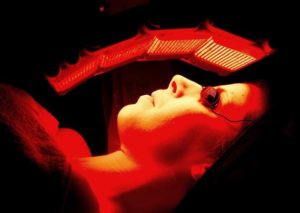 Red light therapy uses low level lasers or light emitting diodes (LED’s) in the red wavelength range to cause a variety of effects in human and animal tissue. Some of the most common uses of red light therapy are cosmetic (reducing acne, for example), but it is also used to provide temporary pain relief and to speed up the healing process. Still, most people have never heard of it before, and so our number one FAQ is: “What is red light therapy?”
Red light therapy uses low level lasers or light emitting diodes (LED’s) in the red wavelength range to cause a variety of effects in human and animal tissue. Some of the most common uses of red light therapy are cosmetic (reducing acne, for example), but it is also used to provide temporary pain relief and to speed up the healing process. Still, most people have never heard of it before, and so our number one FAQ is: “What is red light therapy?”
Red light therapy, which opened the door to other types of light therapy, was first developed by NASA as part of experiments for space shuttle missions. Scientists noticed that astronauts exposed to the light healed faster than normal. NASA’s researchers were excited about this discovery, because it had previously been a problem that astronauts in space wouldn’t heal as fast as normal. It is this observation that led to further development and studies on LED red light therapy.
How Does Red Light Therapy Work?
In studies, red light therapy has been shown to greatly speed up cell healing and repair. Scientists do not know for sure how it works, but most believe it works by altering the energy that is available to the cell. It is possible that LLLT triggers an increase in cellular energy production. However, there is little consensus among scientists as to how does red light therapy work. The bottom line is, scientists just do not know for sure how red light therapy works.
One thing scientists have noticed about red light therapy is that cytochrome c oxidase, an enzyme involved in cellular energy production, seems to accept a transfer of energy directly from the light.
However, there are other effects scientists have noted from LLLT which could also explain its mechanism of action. (Or, perhaps, red light therapy has more than one mechanism of action.) These include:
- Lowering levels of prostaglandin E2
- Lowering levels of prostaglandin-endoperoxide synthase 2
- Lowering levels of interleukin 1-beta
- Lowering levels of tumor necrosis factor-alpha
- Lowering swelling
- Slowing bleeding
- Lowering oxidative stress
- Lessening the influx of neutrophil granulocytes into the cell
Some people are skeptical that some sort of light could have these effects. While I am a die-hard fan of healthy skepticism, a bit of research and logic easily shows that the effectiveness of red light therapy is not only possible- it’s probable.
We already know, for instance, that the human body does react to light. In some cases, the light required to achieve these effects is very small. Consider, for example, that the body produces its own vitamin D when skin is exposed to sunlight. Or that the reaction of the retina to light exposure is how we have vision. Or that the reason we see in color is that our eyes react differently to various wavelengths of light. And there is no debate that the body reacts to lasers, which are made up of condensed light.
So the idea that the skin, hair or other type of tissue might react to light is not as far-fetched as it may sound at first.
You might ask: “if light or even certain colors of light have effects on the body, how come we didn’t know that before?” Well, lights were just to bright and too hot for anyone to get close to them without being burned. The invention of the light-emitting diode has allowed us to more fully examine how light affects us. An LED is capable of producing a bright, powerful light with little heat. This makes it possible to safely place the light closer to the skin (or other tissue) than was ever possible before.
What is Red Light Therapy? Is It a Type of Laser Therapy?
No. Red light therapy is not the same as laser treatment. What is confusing is that many people refer to red light therapy as “low level laser therapy” or “cold laser”. This is a misnomer.
Both laser treatments and red light therapy (or other types of LLLT) use light. The difference is that laser light is “coherent”, meaning all its photons are synchronized. LED light is non-coherent. It does appear, though, that non-coherent light can have beneficial effects. Those effects and the question, “what is red light therapy?” are what this site is all about.